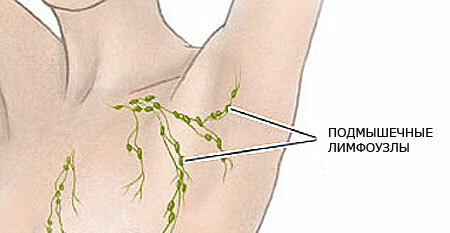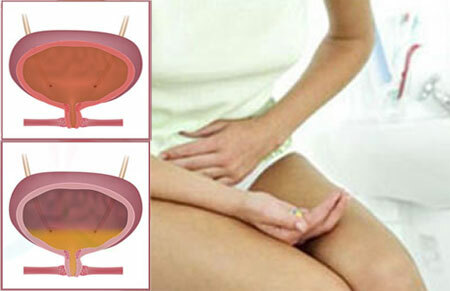The appearance of bald spots and bald patches, even complete baldness, men can explain the fashion trend, or update the image for greater imprint, especially without worrying about it. But, these symptoms of alopecia in women are comparable to a catastrophe.
What is the cause of hair loss and is it possible to fight it?
Contents of
- 1 Alopecia - what is it? Photo
- 2 Androgenic alopecia in women
- 3 Diffuse alopecia - telogen and anagenic species
- 4 Alopecia areata
- 5 Treatment of alopecia in women and men, drugs
- 5.1 Forecast
Alopecia - what is it? Photo

alopecia in women, photo 1
In medicine, the official terminology of alopecia is alopecia( atrichia).Characterized by a sharp thinning or complete absence of hair on the head due to loss, insufficient or complete absence of stages and periods of renewal of cellular hair growth( see photo).
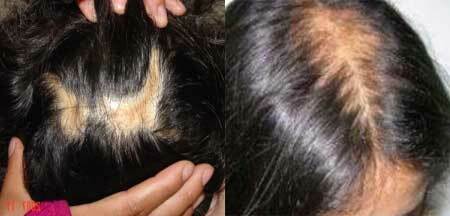
The causes of manifestations of alopecia in women are very diverse. Can be caused by:
- congenital developmental anomalies;
- is the result of a number of pathologies in the complex CNS structure;
- functional disorders of the endocrine glands;
- by atrophic processes in bulbs, due to fungal diseases;
- manifestation, as a consequence of furunculosis.
Therefore, without clarifying the causative factor and species classification of the atrial, independent treatment of alopecia in women will not bring results at best, at worst - exacerbate the situation.
The manifestation of alopecia in women are of two types and three varieties. Specifically, according to the species classification and the nature of the manifestation, a possible cause of hair loss is determined and the choice of treatment is facilitated.
According to the typical attribute of the atria there are cicatricial and non-scarring character.
- In scarring alopecia, complete destruction of the hair follicles( follicle) occurs. This process is caused by inflammatory processes in the follicles, cutaneous atrophy, or scarring. Such an atrium is irreversible and cure is not subject to control.
- The process of non-scarring alopecia passes without previous skin lesions. It is manifested by three species - focal alopecia( nest, circular), androgenic( androgenetic) and diffuse( telogen and anagen).
Androgenic alopecia in women

Androgenic alopecia in women is caused by an excess of the most powerful male hormone DHT( dihydrotestosterone) in the body, stimulating hair loss on the head( androgen-independent hair) and stimulation of growth on the face and pubic( androgen-dependent hair).In addition:
- excess of secretion of testosterone in the body;
- androgenic activity;
- decreased estrogen levels.
The development of the pathological process occurs gradually. Long hair is replaced by a thin, short without pigmentation, which in turn replaces the bell( fluff), eventually disappearing completely. Bald patches are smooth and shiny. Hair follicles are not visible.
Androgenic alopecia is often accompanied by inflammatory skin processes - seborrhea, the presence of acne( acne).
The process of alopecia has a gradual development. At the first stage, hair thinning is noted in the region of the temples, in the second stage, this zone is considerably expanded. Pronounced baldness is noted in the third stage. It affects a wide part of the crown, leaving the frontal zones unchanged.
Diffuse alopecia - telogen and anagenic species

In the telogen phase of diffuse alopecia, there is an abundant loss of hair. In a certain time period, the process can be intensified, a slight renewal of the hair cover is noted, which is caused by the rapid transition of its follicles to the telogen stage( resting stage).
Daily loss of numerous hairs causes its considerable thinning. The cause of diffuse alopecia in both women and men can be:
- deficiency of vitamins in the body;
- infectious processes;
- hematologic disorders;
- consequences of a tight diet;
- stresses and a sharp weight loss;
- long-term medication;
- decreased estrogenic level.
Provocative factors can trigger the development of alopecia in a few weeks, and months after their harmful effects. The reaction of the adaptive syndrome of the body works according to individual characteristics. A woman runs the risk of losing half her curls.
Alopecia in women with a diffuse form of anagenic disease is a more accelerated scenario.
With this type of disease, the loss of hair is evident even at the stage of anagen( rapid hair growth), and it threatens to culminate in a complete collapse - the final loss of the head of hear. The influence of radioactive radiation, pesticides and chemotherapeutic treatment very often gives impetus to the rapid development of pathology.
When eliminating the causes of pathological changes, you can completely restore the hairline. With this pathological phase, the life cycle of the hair onions is not interrupted and with additional stimulation of the hair, it is quite possible to renew it with strong curls.
There is often a change in the color and texture of the hair, they can be curly if they were even before and vice versa.
Symptoms of diffuse alopecia appear in a linear pattern - the appearance of the first strip of baldness is noted in the parietal region of the head, extending to the forehead and whiskey area. Through heavily thinned strands, the skin is clearly visible. If you do not do timely treatment, the strip on the top of the head expands rapidly, covering the entire parietal region of the head.
- The structure of the hair in this case, has a dull unhealthy appearance. They easily break out when combing.
Alopecia areata(
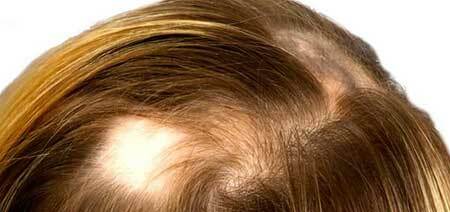
) Alopecia areata are caused by stressful situations, infections, injuries and genetic predisposition. It is classified as an autoimmune disease.
The disease begins with a sudden focal rippling of curls. Foci of alopecia in the form of nests have clear outlines. Perhaps a slight reddening of the skin inside the bald nests.
At the edges of the hearths, healthy hair looks like it's easy to pull out without any effort. A characteristic feature of focal alopecia is the appearance of clavate three millimetric hair outgrowths, with thickened and split ends. Sometimes in the center of the nests, hair growth is noted.
- Characteristic of the emergence of new foci, the expansion and merger of the old.
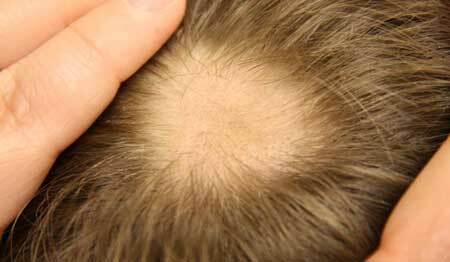
alopecia areata, photo close-up
The duration of existence of nesting foci provokes dystrophic processes in the hair bulb and their atrophy. In addition to focal, nest alopecia, the disease manifests itself:
- Local form with the manifestation of isolated bald focal formations.
- Ribbon-like, characterized by ribbon-like baldness from the occiput to the ear shells and temples( very unfavorable variant of the disease).
- Subtotal form - characterized by slow progression, involving in the process of loss of more than half of the scalp, leaving only small areas of growing, healthy strands. Without proper treatment of focal alopecia of this form, eyelids and eyebrows are exposed to hair loss.
- The total form - which is characterized by the rapid formation and fusion of focal alopecia, leading soon to the complete disappearance of the hairline. The period from the beginning of the process to the final total result lasts no more than three months. In the early stages, the process can be docked.
- Universal - alopecia spreads over the entire surface of the body. The absence of treatment of the disease in the stage of focal formations provokes the development of the pathological process.
- A nasal form accompanied by dystrophic changes in the nail plates and vegetative disorders.
Alopecia areata have staged course and development, the symptoms of manifestations in men and women are the same.
- Stationary flow is characterized by fuzzy detection of zones of damaged "shaky" hair or they are not detected at all. The foci do not increase and do not decrease, they are in a stable state.
- In the progressive stage, the zones of damaged hair are clearly defined. The centers of the bald areas increase in size. In elderly women with gray hair, only the pigmented hairline falls out, gray hair remains untouched. It seems like a momentary graying.
- The regressing stage is characterized by the growth of the vellus( gun) in the bald foci. These fluffy hairs gradually become covered with pigment and coarsen.
- In the progressing current stage, foci with gun growth and zones of loosened weakened hairs are simultaneously detected.
Treatment of alopecia in women and men, drugs

With obvious signs of reducing the density of hair and the presence of bald spots, diagnosis is not difficult. The main measures are aimed at identifying the cause, which has served to develop pathological changes in the hairline. Trichologist will help to find the right direction in diagnosis and will detail the scheme how to treat alapecia of one or another species.
Diagnostics - the first and important step of the proper effective treatment for alopecia!
Diagnostics consists of a whole range of diagnostic techniques and tests consisting of:
- Stages of the hormonal background examination - functional thyroid function, detection of the level of male hormones, examination for the consistency of immune functions.
- Examination of an excluding or confirming syphilitic infection.
- Test of RPR and serological studies.
- Definitions of "B" and "T" of lymphocytes and a sample for easy hair removal( easy sipping).
- Microscopic examination of the hair shaft and bald spots on the fungal flora.
- Surveys of a biopsy from the affected areas on the detection of dermatomycosis, cicatricial pathology that has froliced as a result of granulomatous sarcoidosis, inflammatory reactions in the skin caused by red plaque or systemic lupus.
- Spectral analysis - detecting the deficiency or excess of microelements in the structural tissues of the hair.
Drugs and treatment methods
In the treatment of alopecia of hmate, diffuse and androgenic nature, complex techniques are used including:
- Reception of biostimulants - neuropeptides, tissue extracts of the placenta, etc.
- Vitamin-mineral complexes, including Vitimin "B" and "E";
- Tinctures and extracts of vegetable origin( valerian, eleuterococcus, plantain juice and calanchoe;
- Fito preparations of irritating effect - arnica, gorachetsy, nettles, etc.
- Manual techniques - various massage methods with medical-cosmetic masks, lotions,paraffin masks, cryomassage;
- Use of hardware techniques - galvanization, yonophoresis, scalloped darsonvalization, microcurrent therapy, laser therapy or electrotrichogenesis.( not applicable for marked out
- Injection mesotherapy application
In the treatment of androgenic alopecia in women, hardware procedures are prescribed only after hormone correction, because they can provoke a strong inflow of androgens into the follicles.;
In case of severe pathology, various methods of autotransplantation are used.
Forecast
The prognosis of alopecia treatment depends on the degree of hair loss. Full loss of curls in women - a rare phenomenon. In the androgenic course, the prognosis depends entirely on the timeliness and selection of the right therapy.
Numerous facts of spontaneous recovery have been registered with alopecia areata. But relapses of the disease are not uncommon. An unfavorable prognosis for the development of a total atrial fluke. In this case, the process is irreversible.

